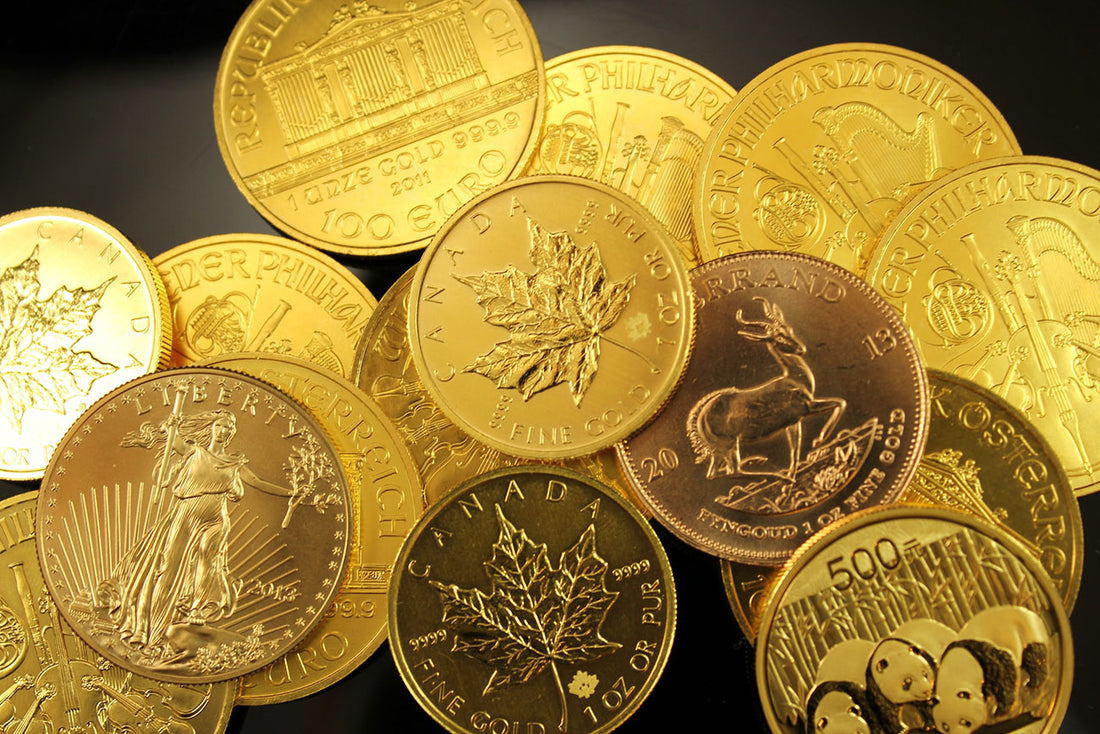One of the top reasons investors buy bullion is to reduce their risks. Gold and silver are widely regarded as safe-haven assets, where you can place your wealth without having to worry about it losing value to inflation or stock market crashes. Bullion also gives you the reassurance of holding a physical asset with real value. You don’t have to worry about executives mismanaging a company or a fund that you’ve invested in. The wealth you have stored in gold and silver is right where you left it, safely under lock and key. It’s a rare experience in today’s world, and it’s one of the reasons gold and silver have so much appeal today.
That said, there are bad actors everywhere in the world these days. Savvy bullion investors should be aware of the potential for bullion scams and most importantly, how to identify and avoid fraud when it comes to bullion investing.
Investors need reliable information about bullion, and that’s why we’re taking a look at bullion scams, how to spot them, and how to protect yourself from fraudsters.
Red Flags: How to Spot Potential Bullion Scams
Whether you’re an experienced bullion investor or you’re only just starting out, it helps to know red flags that can warn you of a potential scam. These red flags could indicate a bad investment or outright fraud. If you feel uncomfortable making a deal, step back, reconsider it, and seek out a more trustworthy avenue for investing.
Unrealistic Promises
Bullion can be a great investment to add to your portfolio, but always be skeptical of unrealistic promises. If someone promises things like doubling your investment in just a few months or that gold can help you get rich quickly, you’re likely walking into some kind of scheme. Gold offers stability and a hedge against other market risks, but don’t fall for pie-in-the-sky promises.
No Transparency
Before you make any investment, you should know who you’re buying from, what the asset is worth, what the risks involved are, and what kind of premiums or fees you’re paying. This is as true for mutual funds as it is for bullion. Some of the questions to ask a bullion dealer include: what percentage of the price is premiums, are there tiered prices for buying in volume, and how much should you expect to pay for insurance? Reputable sellers should be transparent about information like this.
Unbelievable Prices
If you encounter an individual selling gold or silver products at extremely low prices, approach the deal with skepticism. There is rarely a reason for someone to sell bullion at a steep discount unless they are trying to pass off counterfeit bars or coins.

Recent Bullion Scams You Should Know About
Bullion investors should stay informed about the latest bullion scams and counterfeiting efforts. Even when fraudsters get caught, there may be copycats or others who use similar methods.
In 2017, an Orillia man was lured in by a post on his local buy-and-sell Facebook page. The scammer was advertising a gold bar that looked like it was certified by the Royal Canadian Mint and selling for below market value. He purchased the bar at a parking lot, but once the bar was tested, it turned out to be a fake.
In a 2022 scam in North Vancouver, an elaborate ruse involved fraudsters wearing layers of gold-coloured necklaces and rings pretending to be wealthy foreigners who could not access their money in Canada. They offered to sell some of the jewellery they were wearing to passersby. However, the jewellery they were selling was not real gold. Counterfeit jewellery can be easier to pass off to the unaware, but you should always look for a hallmark somewhere on jewellery that gives the weight and purity of the jewellery. Even if there is a hallmark, you should also weigh it if it doesn’t come from a reputable source.
While gold is the most commonly-counterfeited metal, there have also been reports of fake platinum scams. Platinum is very difficult to fake, thanks to its high density, as it is denser than even gold or silver. That means that a 1 oz. coin or bar is actually quite small and thin. It’s roughly twice as dense as silver, which means that a platinum coin or bar should be considerably smaller than a silver one of the same weight. The difficulty in faking platinum comes from replicating the appropriate size. Look into the dimensions that a coin or bar should be before buying platinum, and weigh it before you buy it. If you’re concerned about counterfeit platinum, buy from reputable platinum bullion dealers rather than deal with secondary markets.
How to Avoid Bullion Scams When You Invest
#1 Work with a Trusted Bullion Dealer
The easiest way to avoid bullion scams as an investor is to work with reliable bullion dealers. The bullion industry is a well-established one, and there are plenty of reliable bullion dealers with established credentials, online reviews, and professional service.
At Global Bullion Suppliers, we pride ourselves as a trusted source for gold and an authorized dealer of the Royal Canadian Mint. We provide authenticated bullion products at competitive prices, and we want to help our clients become informed bullion investors who understand everything there is to know about bullion pricing and premiums.
#2 Avoid Online Classifieds and Individual Sellers
Individuals advertising gold or silver on online classifieds are harder to research and verify than bullion dealers with established reputations. Never agree to meet someone selling bullion in a parking lot or somewhere anonymous. It could be a sign that they are trying to sell counterfeits.

#3 Avoid Aggressive Sales Tactics
One of the ways fraudsters operate is by making unrealistic promises about returns and using aggressive sales tactics to get people to buy. In one notable scam in Los Angeles, two men targeted older investors selling bullion products at grossly inflated prices. They did so by making cold calls and taking out ads online and on the radio and persuaded leads with unrealistic claims and fearmongering.
Part of the way they operated was over-promising on the returns on gold and suggesting that there were zero risks. Make no mistake, bullion is an investment like any other. Bullion offers a number of unique qualities that make it a great investment, and it’s a popular safe-haven asset, but no investment comes without risks, and there are never any guarantees.
#4 Look Up Current Gold and Silver Prices
There’s a simple rule of thumb when it comes to investing: if it sounds too good to be true, it probably is. Gold and silver are pretty easy to sell. Bullion dealers offer competitive prices and immediate cash, making it a relatively liquid asset compared to something like real estate or fine art.
If someone is selling gold or silver products for way below market prices, walk away. Look up current market prices before buying gold or silver product. While sellers can’t expect spot price, too steep a discount is usually a warning sign.
#5 Buy Trustworthy Bullion Products
There is a wide range of bullion products available in the world made by national mints and private refiners. If you’re concerned about counterfeits and scams, it’s generally safer to stick to well-known bullion products, especially gold and silver coins. It’s easier to research how to identify counterfeits and authenticate well-known coins.
In Canada, bullion investors are lucky to have ready access to one of the securest bullion products on the planet. The Royal Canadian Mint uses a security technology called Bullion DNA to make their coins easy to authenticate to any bullion dealer. Each coin has a textured maple leaf used as an anti-counterfeiting security measure. Bullion dealers can scan this mark, which contains an encrypted string of code, to authenticate the origin of the coin.
You can find more information below on identifying counterfeits, but sticking to well-known products like gold and silver coins from the Royal Canadian Mint, U.S. Mint, or well-known refiners like PAMP Suisse are great places to start.
How to Identify Counterfeit Bullion
Being able to identify counterfeit bullion personally will give you more confidence when buying silver bullion or gold. There is very little reason to worry about counterfeits if you’re buying from authorized bullion dealers, but it never hurts to know some common methods of identifying counterfeits.
Spotting counterfeit coins can be done first by looking at the markings. Coins from a national mint should have markings that show the weight, purity, mintage year, denomination, and serial number. If any of these are missing, it’s reason to be skeptical.
Coins will also have certain finishes and reliefs that make them harder to counterfeit. Check the edges for ridges that the coin should have. Real coins have reliefs that allow them to stack neatly, but counterfeits may have reliefs that are too high or too low, and coins may not stack properly.
It can be a bit trickier when it comes to bars and other products with fewer details and security measures, but measuring the weight is a great place to start. Bullion coins and bars have their weight stamped onto them, and as an element, gold has a consistent weight. Bring a scale, and if the weight does not match the weight printed on the product, it’s likely that another metal has been used. Remember that one troy ounce is equal to 31.1 grams (rounded).
Bullion scams are not that common, and if you work with reliable bullion dealers, you have very little to worry about. However, if you’re out bargain hunting on online marketplaces, bring a fair degree of caution and learn how to identify counterfeits. If you are approached in a parking lot or another public place with an offer to buy gold, your best bet is probably to walk away.
Staying informed about the latest bullion scams and learning how to identify fakes will protect you and your savings. You should be able to invest in bullion with full peace of mind.

